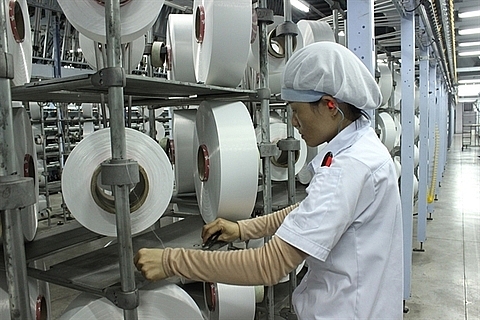Yuan price reduction affects on local industry: experts
 |
| A worker of Dinh Vu Polyester Fibre Plant in the northern port city of Hai Phong. The depreciation of Chinese yuan against the US dollar brings more difficulties to Viet Nam’s yarn industry.- Photo tapchicongthuong.vn |
Viet Nam imports cotton from the US to make yarn products for export to China.
If the yuan continues to fall, Viet Nam's yarn producers will continue to face difficulties, the association said.
Association chairman Vu Duc Giang told Vietnam News Agency that due to the US-China trade war, in the period from May to September 2018, Viet Nam yarn export price to China dropped from an average of US$3.05 to $2.99 per kilo, down by 1.97 per cent, causing average yarn export value each month to decrease by 2.5 per cent.
According to experts, the US-China trade saw Chinese yarn importers buy the minimum quantity to meet manufacturers’ demand.
Giang said Viet Nam yarn exports had been mainly shipped to China, accounting for more than 60 per cent of total annual yarn export value to the world. Viet Nam is also one of China’s major yarn suppliers, with a continuously growing market share.
In 2014, Viet Nam ranked third in China's yarn import markets, after India and Pakistan. In 2017 and 2018, Viet Nam rose to the first place, accounting for 30 per cent of China's yarn imports, higher than both India and Pakistan.
The Dam San Joint Stock Company’s representative said in the past, the company sold 1,400 tonnes of yarns to China, but now the volume was declining sharply and even in September, it would not have export contracts to sign.
According to some enterprises, Chinese partners have pressured firms to reduce further import price.
Other markets such as South Korea, Japan, Egypt, Turkey, the Philippines and Taiwan still have orders but only small quantity.
They also face fierce competition from domestic foreign-invested (FDI) enterprises and businesses from competing countries such as India, Thailand, Indonesia, and Pakistan to get contracts.
The selling price is still on a downward trend and there is no sign of recovery, while China has launched a large amount of cotton stockpiles, which makes cotton prices fall sharply, the ndh.vn reported.
The Viet Nam Yarn Association said this year, the export volume of Viet Nam yarn industry would reduce by 10-15 per cent year on year and the selling price had also dropped from $3.5 to $2.8 per kilo at present. Therefore, the industry could suffer no less than $500 million.
Meanwhile, Phi Viet Trinh, General Director of the Ho Guom Garment Group, said his company exports to Europe, Japan and South Korea who pay in US dollar so the depreciation of yuan would not have much effect on his, the Vietnam News Agency reported.
Than Duc Viet, General Director of the May 10 Corporation, also said the May 10 had not had much export volume to China and its payment was mainly in US dollar so it would not be affected much by the yuan depreciation.
For the domestic leather and footwear industry, Phan Thi Thanh Xuan, Secretary General of the Viet Nam Leather and Footwear Association (Lefaso), said enterprises had to import many raw materials from China. However, these contracts mainly came from large-scale businesses and foreign direct investment firms so the payment for the contracts were in US dollar.
Lefaso was following developments in import and export activities of the industry to be able to inform its members, especially in the last quarter when the enterprises promote production meeting higher demand for holidays.
What the stars mean:
★ Poor ★ ★ Promising ★★★ Good ★★★★ Very good ★★★★★ Exceptional
Related Contents
Latest News
More News
- Pivotal stage of growth paves way for rise in M&As (December 03, 2025 | 10:00)
- Positive projections for M&A interest from Thailand (December 03, 2025 | 09:40)
- Manifesting the first line of defence in cybersecurity (December 03, 2025 | 09:00)
- The transformational role AI can play in accounting arena (December 03, 2025 | 08:00)
- Unlocking 5G-AI potential in Singapore (December 03, 2025 | 08:00)
- Data-driven strategies vital for a fast-evolving nation (December 02, 2025 | 09:41)
- Policy to practice: how Vietnam can lead the region (November 26, 2025 | 16:03)
- Mobilising private capital at scale vital for climate battle (November 26, 2025 | 15:36)
- VILAF and Yoon & Yang launch Vietnam - Korea Practice Unit (November 26, 2025 | 15:16)
- Trademark disputes challenge foreign firms in Vietnam (November 24, 2025 | 15:30)

 Tag:
Tag:






















 Mobile Version
Mobile Version